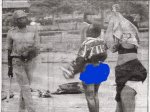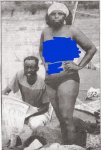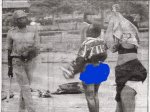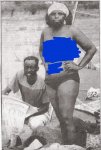Sanyatti
Member

1992, When mothers of political prisoners decided to strip to put pressure on the government to release their sons.
For centuries stripping was used by African women to put curses on their offenders and was also a tactic for resistance.
A woman would stand with her back toward the offender, remove her undergarments, bend forward, and lift her skirt. It was sometimes used among co-wives.
The Kikuyu called it Guturama; Luos, Gumo; Luhyas, Okhufulama.
The protestors at Uhuru Park included Monica Wangu Wamwere(mother of Koigi Wamwere), Milka Wanjiku Kinuthia (mother of Rumba Kinuthia), Ruth Wangari Thungu (mother of Harun Wakaba Thungu), Leah Wanjiru Maungai (mother of Samuel Kang'ethe Maungai), Gladys Thiitu Kariuki (mother of Mirugi Kariuki), and Priscilla Mwara Kimani (mother of Hosea Gitau).
The use of stripping to curse was found in many ethnic groups in Kenya and Africa.
Among the Yorubas of Nigeria the most powerful curse of all is that of a naked woman. They call it ase. By exposing their nakedness women showed the power to bring things into existence.
With time it became a form of protest and resistance tactic. In Southwestern Nigeria women once marched into the king's palace and stripped, protesting a new tax on women only.
In 1922 Mary Muthoni Nyanjiru, stripped in front of 8,000 people outside a Nairobi police station to protest the imprisonment of Harry Thuku by British authorities. The public stripping by mothers of political prisoners in Uhuru Park in 1992, powerfully echoed this incident.
As a form of resistance, stripping, was available to older women only who were known or presumed to be mothers. Curse by stripping was not a resource a young woman could employ even if she were a mother. In a nutshell, motherhood was a resource when combined with the respect accorded to older women.
However stripping was only used as a last resort. For example the women first met Attorney General Amos Wako to express their concerns. Despite Wako promising to review their case nothing was forthcoming. The women then went on hunger strike , with well wishers and sympathisers such as Prof Wangari Maathai expressing solidarity with them , and setting up tents for them to sleep in.
The government reacted by sending a contingent of GSU to evict the women and their sympathisers. The police were so aggressive that many were beaten or trampled. Prof Wangari Maathai was hospitalised after the brutal incident. That's the point women decided to strip.

Attachments
-
137 KB Views: 0
-
204.2 KB Views: 0
-
263 KB Views: 0
-
137 KB Views: 0
-
178.2 KB Views: 0





